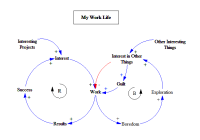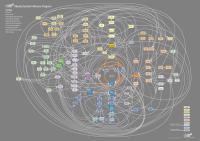Systems Science
Overview
A system is set of things that are interconnected in ways that result in the generation of identifiable behavioral patterns over time. Systems Science is an interdisciplinary field that studies the complexity of systems in nature, social or any other scientific field. Some of the systems science methodologies include systems dynamics modeling, agent-based modeling, microsimulation, and Big Data techniques. Systems science thinking can help researchers to understand the factors influencing the distribution and determinants of health and disease in populations, by providing information on the broad picture on how individuals and other components of populations are interconnected in society in scenarios in which researchers cannot controlled the environment. Therefore, system science thinking can help researchers to find answers on how interventions may generate change in disease outcomes given the system multilevel factors present in populations.
Description
Sometimes we encounter complex public health problems that cannot be analyzed adequately using traditional epidemiologic models. The relationships among variables may change over time and involve feedback loops, there may be long delays between causes and effects, and change in one part of the system may yield unintended consequences in another. Grounded in the core principles of engineering, system dynamics was developed to identify the connections between changing system structure and system behavior. System dynamics models aim to designate a structure that can replicate the key characteristics of a dynamic problem independent of exogenous factors. A system dynamics approach emphasizes a continuous view of complex social, managerial, economic, or ecological systems. A system in this framework is characterized by interdependence of units, mutual interaction, information feedback systems, and circular causality.
to the insanely complex (this map was commissioned by the government of Tony Blair as part of a comprehensive plan to combat obesity in the UK; see Vandenbroeck et al, below, for a full description of how the systems model was created):
Central to system dynamics modeling are stock and flow relationships. Stocks are entities that accumulate or lessen over time; these are the sources of the system’s disequilibrium or changing behavior. Flows are the rates of change in stocks.
Creating a system dynamics model is an iterative process that involves collaboration among multiple stakeholders. In addition to refining the systems map, participants provide information about reasonable levels of stocks and rates of flow necessary to create computer simulation models that describe how the system works. The simulation models are calibrated using experimental data and may be tested to see if they can reproduce historical patterns before they are used to make predictions. When a model has been deemed reliable, it is initialized into a “steady state,” or a state of dynamic equilibrium, involving a given number of stocks and rates of flow based on known data. Different scenarios are then simulated by varying the stocks and flows.
System dynamics modeling may be used when component stocks and flows are identifiable and measurable, when feedback loops are both operative and known, and especially when variation is central to the research hypothesis. It is particularly suited to tackling public health issues in which inputs are drawn from across various disciplines, such as health policy, chronic disease management, health care capacity, and “syndemics”–the existence of overlapping syndromes or epidemics within populations.
Readings
Textbooks & Chapters
Systems Dynamics Review. Chichester, UK. Wiley-Blackwell, Ltd.
Methodological
Randers J, ed. Elements of the System Dynamics Method. 1st ed. Cambridge MA: MIT Press. 1980.
Richardson GP. Feedback Thought in Social Science and Systems Theory. 1st ed. Philadelphia, PA: University of Pennsylvania Press. 1991.
Applications
De Savigny D and Adam T, eds. Systems Thinking for Health Systems Strengthening. Geneva: World Health Organization. 2009.
Vandenbroeck P, Goossens J, Clemens M. Tackling Obesities: Future Choices–Building the Obesity System Map. UK: Government Office for Science. 2007. (www.foresight.gov.uk)
How to Draw a Systems Map
DePinho H. Steps for Creating a Systems Map
Kirkwood CW. System Dynamics Methods: A Quick Introduction (1998), Chapter 1.
Methodological Articles
Ackermann F, Andersen DF, Eden C Richardson GP. Using a group decision support system to add value to group model building. System Dynamics Review. 2010: 26(4); 335-346.
Barlas Y. Model validation in system dynamics. Presented at 1994 International System Dynamics Conference; 1994. Stirling, Scotland.
Homer JB. Structure, data, and compelling conclusions: Notes from the field. System Dynamics Review. 1997; 13(4): 293-309.
Homer JB, Hirsch GB. System Dynamics Modeling for Public Health: Background and Opportunities. Am J Public Health. 2006; 96(3): 452-458.
Leischow SJ, Milstein B. Systems Thinking and Modeling for Public Health Practice. Am J Public Health. 2006; 96(3): 403-5.
Ness RB, Koopman JS, Roberts MS. Causal System Modeling in Chronic Disease Epidemiology: A Proposal. Annals of Epidemiology. 2007; 17(7): 564-8.
Richardson, GP and Andersen DF. Systems Thinking, Mapping, and Modeling for Group Decision and Negotiation. In: Eden C and Kilgour DN, eds, Handbook for Group Decision and Negotiation. Dordrecht: Spring; 2010: 313-324.
The challenge of complexity in health care
Author(s): P Plesk, T Greenhalgh
Journal: BMJ
Year published: 2001
Author(s): JD Sterman
Journal: Am J Public Health
Year published: 2006
Estimating Neighborhood Health Effects: The Challenges of Causal Inference in a Complex World
Author(s): AV Diez-Roux
Journal: Social Science and Medicine
Year published: 2004
Causal Thinking and Complex System Approaches in Epidemiology
Author(s): S Galea, M Riddle, GA Kaplan
Journal: International Journal of Epidemiology
Year published: 2010
Author(s): N Pearce, F Merletti
Journal: International Journal of Epidemiology
Year published: 2006
Social network analysis and agent-based modeling in social epidemiology
Author(s): AM El-Sayed, P Scarborough, L Seemann, S Galea
Journal: Epidemiologic Perspectives & Innovations
Year published: 2012
Network analysis in public health: history, methods, and applications
Author(s): DA Luke, JK Harris
Journal: Annu Rev Public Health
Year published: 2007
Application Articles
Dangerfield B, Fang Y, Roberts C. Model-based scenarios for the epidemiology of HIV/AIDS: The consequence of highly active antiretroviral therapy. System Dynamics Review. 2001; 17(2): 119-150.
Garedew, E., M. Sandewall, and U. Soderberg, A dynamic simulation model of land-use, population, and rural livelihoods in the Central Rift Valley of Ethiopia. Environ Manage, 2012. 49(1): p. 151-62.
Hirsch G, Homer J, Evans E, Zielinaki A. A System Dynamics Model for Planning Cardiovascular Disease Interventions. Am J Public Health. 2010; 100(4): 616-622.
Milstein B, Homer J, Hirsch G. Analyzing National Health Reform Strategies with a Dynamic Simulation Model. Am J Public Health. 2010; 100(5): 811-819.
Panjeti, V.G. and L.A. Real, Mathematical models for rabies. Adv Virus Res, 2011. 79: 377-95.
Qi, C. and N.B. Chang, System dynamics modeling for municipal water demand estimation in an urban region under uncertain economic impacts. J Environ Manage, 2011. 92(6): 1628-41.
Thompson KM, Tebbens RJD, Using system dynamics to develop policies that matter: Global management of poliomyelitis and beyond. System Dynamics Review. 2008; 24(4):433-449.
Wanduku, D. and G.S. Ladde, A two-scale network dynamic model for human mobility process.Math Biosci, 2011. 229(1): 1-15.
Agent-based simulation platforms: review and development recommendations
Author(s): SF Railsback, SL Lytinen, SK Jackson
Journal: Simulation
Year published: 2006
Modeling and analysis of global epidemiology of avian influenza
Author(s): DM Rao, A Chernyakhovsky and V Rao
Journal: Environmental Modelling & Software
Year published: 2009
Author(s): AM El-Sayed, L Seemann, P Scarborough, S Galea
Journal: Am J Epidemiol
Year published: 2013
Author(s): BT Smith, PM Smith, S Harper, DG Manuel, CA Mustard
Journal: Journal of epidemiology and community health
Year published: 2013
Author(s): ADM Briggs, A Kehlbacher, R Tiffin, T Garnett, M Rayner, P Scarborough
Journal: BMJ open
Year published: 2013
System dynamics modeling for public health: background and opportunities
Author(s): JB Homer, GB Hirsch
Journal: American journal of public health
Year published: 2006
A simple model predicting individual weight change in humans
Author(s): DM Thomas, CK Martin, S Heymsfield, LM Redman, DA Schoeller, JA Levine
Journal: Journal of biological dynamics
Year published: 2011
Author(s): SJ Mooney, DJ Westreich, AM El-Sayed
Journal: Epidemiology
Year published: 2015
Author(s): MJ Paul, M Dredze
Journal: Association for the Advancement of Artificial Intelligence
Year published: 2011
Software
Description: A multimethod simulation software that supports agent-based, discrete event and systems dynamic simulations.
Price: Varies by version. Educational, researcher, professional and advanced versions available.
Websites
3-minute TED Talk overview:
http://www.youtube.com/watch?v=UB2iYzKeej8
Although this is a subscription website, at the bottom of the home page are links to a dozen free articles that briefly describe the nuts and bolts of system dynamics (e.g., “Causal Loop Diagrams,” “Stocks and Flows,” etc):
http://www.thesystemsthinker.com/
The System Dynamics Society is an international forum for research, educators, consultants, and practitioners from all disciplines to share ideas. Each July it hosts an annual conference (2013: Cambridge, MA, 2014: Delft, Netherlands)
http://www.systemdynamics.org/
Within the society, there is a dedicated Health Policy Forum:
http://https://systemdynamics.org/special-interest-groups/health-policy/
The Bristol Centre for Complexity Sciences provides postgraduate training in complex systems research. Their website includes a helpful definition of complex systems:
http://www.bris.ac.uk/bccs/about/complexity/
and is a good resource for seminars and events relating to the subject.
The Complex Systems Society is a European-based resource for anyone working in the field that hosts periodic conferences (2013: Barcelona):
http://www.complexssociety.eu/
The Santa Fe Institute is a locus for complex systems research, education, and interdisciplinary collaboration:
https://www.santafe.edu/
There is also a Mailman student group devoted to Complex Systems Approaches to Population Health (CSAPH) that hosts periodic seminars and trainings:
http://www.mailman.columbia.edu/students/student-life/student-groups/complex-systems-approaches-population-health-csaph
Courses
Free online “Introduction to Complexity” course hosted by the Santa Fe Institute:
http://www.complexityexplorer.org/
Free online “Managing Complexity: A Systems Approach” course hosted by the Open University:
https://www.open.edu/openlearn/science-maths-technology/computing-ict/managing-complexity-systems-approach-introduction/content-section-15.3
Isee systems training:
https://www.iseesystems.com/store/training/applying-systems-thinking/, trainings in STELLA and iThink.
Van den Broeck, W., et al., The GLEaMviz computational tool, a publicly available software to explore realistic epidemic spreading scenarios at the global scale. BMC Infect Dis, 2011. 11:37.

